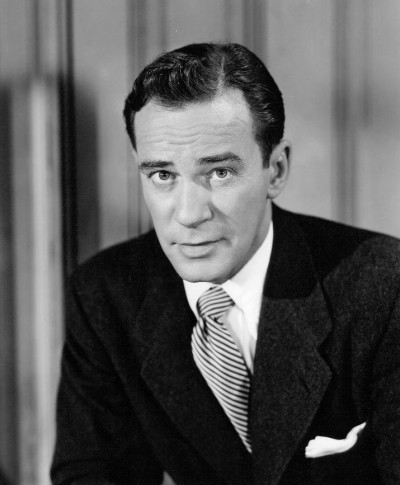Richard Carlson (Richard Dutoit Carlson)

The son of a lawyer, Richard Carlson was born in Albert Lea in southern Minnesota. He graduated from the University of Minnesota with an Master of Arts degree, summa cum laude and Phi Beta Kappa. He appeared on the Broadway stage in the 1930s after studying and teaching drama in Minnesota. His first film role was in the 1938 David O. Selznick comedy The Young in Heart. He worked as a freelance actor, appearing in many different film studio works, beginning in 1939 when he moved to California. Before the war, he appeared mostly in comedies and dramas, including The Little Foxes and Too Many Girls with Lucille Ball in 1940. Carlson served in the United States Navy as a pilot in World War II, interrupting his acting career. After returning he found it difficult to procure new roles, and his future in Hollywood remained in doubt until 1948. In that year, Carlson was cast in two low-budget film noir releases, Behind Locked Doors and The Amazing Mr. X. Despite this, real success in Hollywood eluded him until 1950, when he co-starred with Deborah Kerr and Stewart Granger in the highly successful jungle adventure film King Solomon’s Mines, shot on location in Africa. Other films followed, including the World War II naval action film Flat Top. Carlson slowly began to rebuild his career, finding work in the newly emergent science fiction and horror B films of the 1950s. He appeared in a number of horror and science fiction films, including three 3-D films: The Maze (1953) and the classics It Came from Outer Space (1953) with Barbara Rush, Creature from the Black Lagoon (1954) with Julia Adams, and The Magnetic Monster. His success in the genre led him to the director’s chair for the 1954 science fiction film Riders to the Stars, in which he also starred. In addition to science fiction work, he had a recurring role as a writer of “science fact” in The Bell Laboratory Science Series. On July 14, 1951, Carlson and then U.S. Senator Hubert Humphrey were the guests on the CBS live variety show, Faye Emerson’s Wonderful Town, in which hostess Faye Emerson visited Minneapolis to accent the kinds of music popular in the city. In addition to writing and directing various film and television projects, Carlson also was the star of the Cold War drama television series I Led Three Lives from 1953 to 1956. He was featured in 1957 in The Helen Morgan Story. That same year, he was cast as two different ministers, Rabbi Avraham Soltes and Father William Wendt, in the episodes “The Happy Gift” and “Call for Help”, respectively, of the syndicated religion anthology series, Crossroads.
In the 1958-1959 television season, Carlson portrayed Colonel Ranald Mackenzie of the 4th Regiment of the United States Cavalry in the syndicated western series, Mackenzie’s Raiders, with Morris Ankrum, Louis Jean Heydt, Jack Ging, and Brett King among the “Raiders”. The series is set at the former Fort Clark near Brackettville in southwestern Texas, where the real Mackenzie was stationed during much of the 1870s. However, the episodes were filmed at the former Corriganville Movie Ranch in Simi Valley, California. In the series theme, Mackenzie and his men must protect the American border from an assortment of outlaws from both the United States and Mexico. Yet the Raiders cannot risk being caught within Mexico, or they would lose the open support of their own government. In 1959, Carlson was cast as Paul Drake in “The Faithless” of the NBC western series Riverboat, with Darren McGavin. In the story line, Drake is an escaped prisoner with medical training being transported on the river vessel, the Enterprise, back to jail. Having lost his religious faith, Drake refuses to render medical assistance to a two-year-old girl stricken with a communicable disease which threatens the entire vessel. William Phipps and Jeanne Bates play the parents of the child. Bethel Leslie portrays Cathy Norris. In 1965, he played a mad scientist who creates a mutant, killer octopus in the Voyage to the Bottom of the Sea episode “The Village of Guilt”. In the final two seasons of CBS’s Perry Mason, Carlson made two guest appearances, both times as the murder victim. In 1964 he played Anthony Fry in “The Case of the Tragic Trophy;” in 1966, he played Clete Hawley in “The Case of the Avenging Angel.” Carlson’s last movie role was in the 1969 Elvis Presley/Mary Tyler Moore film, Change of Habit. His last acting role was in a 1975 episode of the television series Khan!. In physical appearance, Carlson was sometimes compared to Hugh Marlowe, who was one year older and starred in the science fiction classics The Day the Earth Stood Still and Earth vs. the Flying Saucers. The two men were not related. Carlson died of a cerebral hemorrhage on November 25, 1977, in Encino, California. He was buried in Los Angeles National Cemetery, in West Los Angeles. For his contribution to the television industry, Richard Carlson has a star on the Hollywood Walk of Fame at 6333 Hollywood Blvd.
Born
- April, 29, 1912
- USA
- Albert Lea, Minnesota
Died
- November, 25, 1977
- USA
- Encino, California
Cause of Death
- cerebral hemorrhage
Cemetery
- Los Angeles National Cemetery
- Los Angeles, California
- USA



